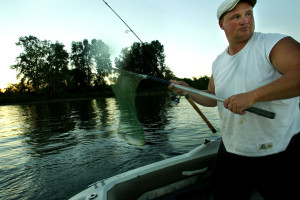forum
library
tutorial
contact

Pikeminnow Fishery Opens
by Mark GibsonThe Dalles Chronicle, May 3, 2018
|
the film forum library tutorial contact |

|
Pikeminnow Fishery Opensby Mark GibsonThe Dalles Chronicle, May 3, 2018 |
Bounty aims to protect salmon
 The northern pikeminnow bounty fishery opened Monday, May 1, with 324 caught opening day in The Dalles, according to Eric Meyer, who was taking and counting the catch May 2, with over 300 counted by mid-afternoon.
The northern pikeminnow bounty fishery opened Monday, May 1, with 324 caught opening day in The Dalles, according to Eric Meyer, who was taking and counting the catch May 2, with over 300 counted by mid-afternoon.
"The water is a little fast, a little high," he said of the season opening.
Meyer was busy, though, collecting fish into large coolers and answering questions from numerous fisherman signing up for the program.
"I've never seen the parking lot so full," he said of the many boat trailers and vehicles parked at the marina.
Northern pikeminnow feed heavily on salmon and steelhead juveniles.
The Pikeminnow Sport Reward Fishery Program, funded by the Bonneville Power Administration (BPA) and administered by the Pacific States Marine Fisheries Commission, pays anglers for each northern pikeminnow that they catch. In 2017, the bounty fishery got underway in a big way, with 7,523 fish caught in The Dalles area during the first full week of fishing, according to data provided by the Bonneville Power Administration.
The program ended the season with 191,479 fish caught, compared to 225,350 caught in 2016.
This year, state fish and wildlife biologists have tagged and released up to 1,000 fish into the Columbia and Snake River, each worth $500 in additional bounty: The program pays registered anglers $5 to $8 per fish, nine inches or longer.
Working for the fisheries commission is the Washington Department Fish and Wildlife, which collects and counts the catch at stations located along the river, locally in The Dalles and Rufus, and the Oregon Department of Fish and Wildlife, which is responsible for the research upon which the program is based.
The goal of the program is not to eliminate northern pikeminnow, but rather to reduce the average size and curtail the number of larger, older predators, according to information provided by the BPA.
Reducing the number of these predators can greatly help salmon and steelhead juveniles making it out to sea.
learn more on topics covered in the film
see the video
read the script
learn the songs
discussion forum
